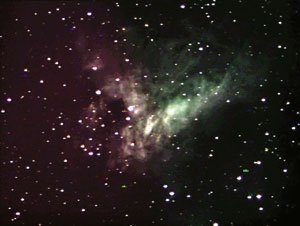This is an article that I wrote last March. But it is
information that I think is appropriate to mention again,
especially if you missed it last year.
This is an article that I wrote last March. But it is information that I think is appropriate to mention again, especially if you missed it last year.
Astronomer Charles Messier (1730-1817) devoted much of his life searching the heavens for comets. In doing so he would come across many objects that at first he thought were comets, but not to be. What they turned out to be were stationary objects such as nebulas, galaxies, clusters and double stars.
His love was finding comets, and had less interest in these other confusing objects that would just get in his way. So he published his findings so other astronomers wouldn’t have to go through what he did when looking for comets.
He started out with some 45 objects and they came to be called “The Messier Objects.” It was odd that he would later become more famous for his Messier Objects than for his comet findings. As time went on others were added to the list by astronomers. Until today we have a total of 109. Most of these deep-sky objects can be seen with binoculars or small telescopes.
Two centuries later, backyard observers still consider many of these splendid “M” objects the jewels of the night sky.
Each month, as the skies slowly change, new objects show up until by the end of the year you have seen them all. But there is one way you can see them all in one long evening.
Each spring amateur astronomers around the world run a Messier “Marchathon.” A visual race through the night sky to get a glimpse of all 109 Messier Objects in a single night, from dusk to dawn. If you are lucky enough to catch 50 to 70 consider that a good night. The key here, of course, is getting away from the city lights; you will need all the darkness you can muster. But that doesn’t mean you can’t be successful from your own back yard. Plus, it’s nice to know that your own warm bed is only a few steps away, should you decide to give it up early.
In our area we are lucky to have southern San Benito County. What a wonderful place to see these great wonders. But you just can’t stop wherever you want to and set up your gear.
You need to know someone who lives in that part of the county and would be nice enough to let you use a small patch of his dirt one night for about 12 hours.
And that best night this year would be around March 18. No moon to get in the way (new moon).
It just so happens that I have a friend who owns property down there and is nice enough to let us use a small portion of his place every now and then to star gaze. He really appreciates the fact that we clean up after ourselves.
A couple of months ago I went down to southern San Benito County to do some stargazing, and what a beautiful night it was.
I saw at least three times the amount of stars than I would have seen here in the city – made it a lot easier to pick up more of those harder-to-see Messier Objects. Hope you have the time to have your own Messier hunt, maybe in your own backyard.
If you do give it a try, be sure to be well equipped, with such items as warm clothing, binoculars, telescope, if you have one, star charts, red flashlight, chair, table, maybe a sleeping bag and for Heaven’s sake don’t forget some good munchies, and some hot coffee or chocolate, especially if you come with us.
I have some friends who wont come if they know there is not going to be any food of some kind. And you know who you are.
The Messier Marchathon is an athletic event of sorts: Participants race around the sky like maniacs for a whole night only to end up where they started. The Messier Marchathon does prove something very important: Astronomy can be fun. Clear Skies.
David Baumgartner is in local real estate and is an avid amateur astronomer. His Sky Watch column appears monthly.











